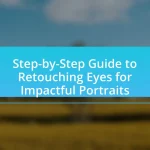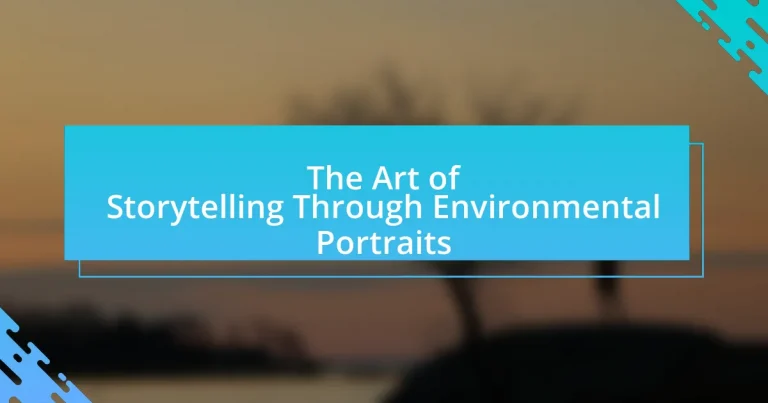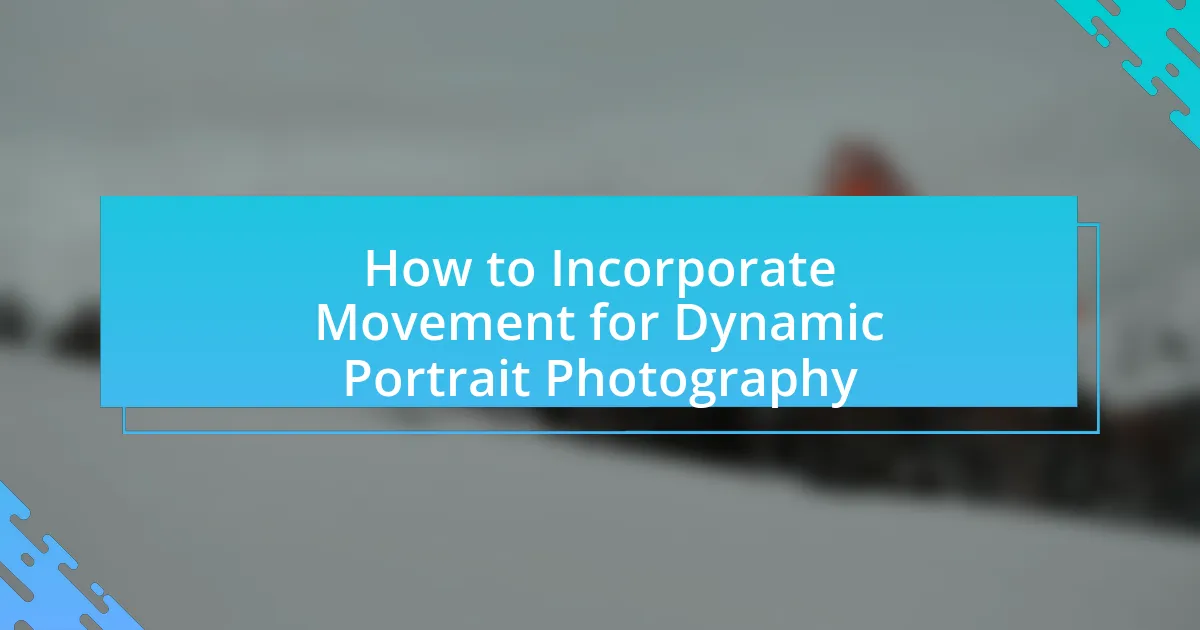The article focuses on the art of storytelling through environmental portraits, a photographic technique that captures subjects within their surroundings to convey their personality and experiences. It explores how environmental portraiture integrates context, emotion, and composition to enhance narratives, emphasizing the importance of the subject’s environment in shaping their story. Key elements such as lighting, expression, and location choice are discussed, along with the challenges photographers face in creating impactful images. Ethical considerations, best practices, and techniques for developing a unique storytelling style are also highlighted, providing a comprehensive overview of how to effectively communicate narratives through environmental portraits.
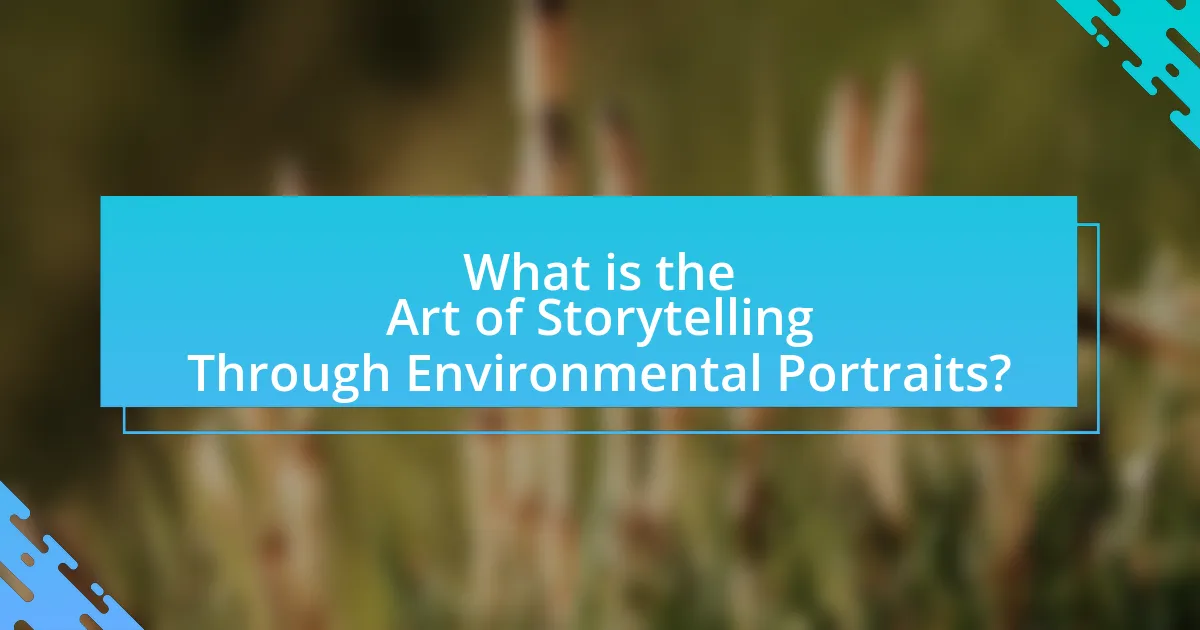
What is the Art of Storytelling Through Environmental Portraits?
The art of storytelling through environmental portraits involves capturing subjects within their surroundings to convey their personality, experiences, and context. This photographic technique emphasizes the relationship between the subject and their environment, allowing viewers to gain insights into the subject’s life and story. For example, a portrait of a musician in their studio not only highlights their identity but also reflects their creative process and influences, enhancing the narrative conveyed through the image. Environmental portraits effectively communicate emotions and stories by integrating elements of the setting, thus creating a richer visual narrative.
How does environmental portraiture convey stories?
Environmental portraiture conveys stories by integrating subjects within their surroundings, which provides context and depth to their narratives. This photographic style captures not only the individual but also the environment that shapes their identity, experiences, and emotions. For instance, a portrait of a musician in their studio reveals their creative process and passion, while a farmer in a field illustrates their connection to the land and livelihood. Such compositions allow viewers to infer relationships, struggles, and triumphs, effectively transforming a single image into a multifaceted story.
What elements contribute to storytelling in environmental portraits?
Elements that contribute to storytelling in environmental portraits include the subject’s expression, the surrounding environment, and the use of light. The subject’s expression conveys emotions and intentions, while the environment provides context that enhances the narrative by reflecting the subject’s personality or life circumstances. Additionally, the use of light can create mood and focus, guiding the viewer’s attention to key elements of the story. These components work together to create a cohesive visual narrative that engages the audience and communicates deeper meanings.
How do subjects and settings interact to enhance narratives?
Subjects and settings interact to enhance narratives by creating a dynamic relationship that deepens character development and contextualizes the story. The subject, typically a character, is influenced by their environment, which shapes their actions, emotions, and motivations. For instance, a character’s struggle in a desolate landscape can symbolize their internal conflict, thereby enriching the narrative. This interaction is evident in literature and film, where settings often reflect the themes and emotional states of the subjects, such as in the works of authors like Ernest Hemingway, who used settings to mirror the psychological landscapes of his characters. Thus, the interplay between subjects and settings not only drives the plot but also evokes emotional responses from the audience, making the narrative more compelling.
Why is storytelling important in photography?
Storytelling is important in photography because it transforms a mere image into a narrative that engages viewers emotionally and intellectually. By incorporating elements such as context, subject expression, and composition, photographers can convey deeper meanings and evoke feelings, making the photograph more impactful. Research indicates that images with a clear narrative can increase viewer retention and connection, as demonstrated in studies where storytelling visuals led to a 65% higher recall rate compared to non-narrative images. This illustrates that effective storytelling in photography not only captures attention but also fosters a lasting impression.
What role does emotion play in visual storytelling?
Emotion is a critical component of visual storytelling, as it engages the audience and enhances their connection to the narrative. Visual storytelling relies on imagery to evoke feelings, allowing viewers to experience the story on a deeper level. Research indicates that emotionally charged images are more memorable and impactful; for instance, a study published in the journal “Cognitive Science” found that emotional content significantly improves memory retention. This demonstrates that emotion not only enriches the storytelling experience but also aids in the audience’s understanding and recall of the narrative.
How can storytelling differentiate a photographer’s work?
Storytelling can differentiate a photographer’s work by adding depth and context to their images, transforming simple visuals into compelling narratives. When photographers incorporate storytelling elements, they engage viewers emotionally, allowing them to connect with the subject on a personal level. For instance, a study by the University of Southern California found that images paired with narratives are remembered 22 times more than images alone, highlighting the power of storytelling in enhancing recall and emotional impact. This approach not only showcases the photographer’s technical skills but also their ability to convey a message, making their work stand out in a saturated market.
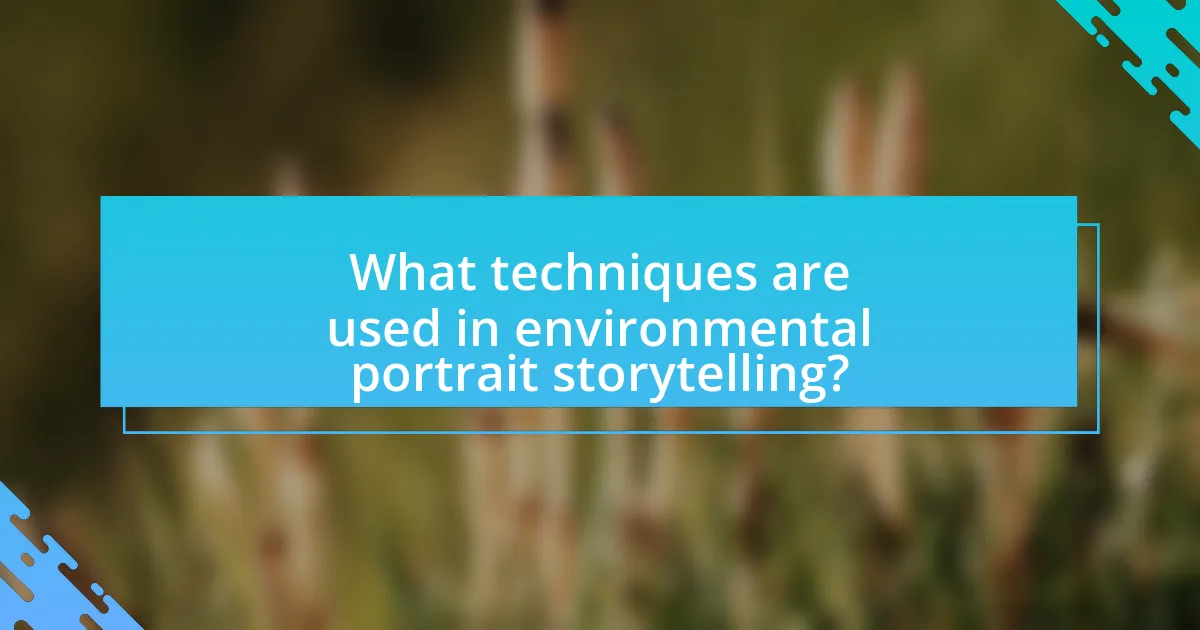
What techniques are used in environmental portrait storytelling?
Environmental portrait storytelling employs techniques such as composition, lighting, and context to convey a subject’s narrative. Composition involves framing the subject within their environment to highlight their relationship with it, while lighting enhances mood and emphasizes features. Context is crucial, as it provides background elements that enrich the story, revealing insights about the subject’s life or profession. These techniques collectively create a compelling visual narrative that engages viewers and communicates deeper meanings.
How do composition and framing affect storytelling?
Composition and framing significantly influence storytelling by guiding the viewer’s focus and shaping the narrative context. Effective composition organizes visual elements to create a balanced and engaging image, while framing directs attention to specific subjects or actions, enhancing emotional impact. For instance, the rule of thirds in composition can lead to more dynamic images, making the story more compelling. Additionally, framing techniques, such as using natural elements to border a subject, can evoke a sense of place and context, enriching the narrative. Studies in visual storytelling demonstrate that well-composed and framed images can elicit stronger emotional responses, thereby enhancing the overall storytelling experience.
What are the best practices for composing an environmental portrait?
The best practices for composing an environmental portrait include selecting a meaningful background, utilizing natural light, and incorporating elements that reflect the subject’s personality or story. A meaningful background enhances the narrative by providing context, while natural light creates a more flattering and authentic appearance. Additionally, including personal items or relevant props can deepen the viewer’s understanding of the subject’s life and environment. These practices are supported by photography experts who emphasize the importance of context and authenticity in visual storytelling.
How can lighting influence the mood of a portrait?
Lighting significantly influences the mood of a portrait by affecting the emotional tone and visual impact of the image. Different lighting techniques, such as soft, diffused light, can create a calm and serene atmosphere, while harsh, direct light can evoke tension or drama. For instance, Rembrandt lighting, characterized by a triangle of light on the subject’s cheek, often conveys depth and introspection, enhancing the emotional connection with the viewer. Studies in photography demonstrate that the quality, direction, and color of light can alter perceptions; for example, warm tones can evoke feelings of comfort and happiness, while cool tones may suggest sadness or detachment. Thus, the manipulation of lighting is a crucial tool in portrait photography that shapes the viewer’s emotional response.
What role does the subject’s environment play?
The subject’s environment plays a crucial role in shaping the narrative and emotional context of environmental portraits. The surroundings provide visual cues that enhance the story being told, reflecting the subject’s personality, lifestyle, and experiences. For instance, a portrait of an artist in their studio conveys creativity and passion, while a farmer in a field illustrates hard work and connection to nature. Research indicates that environmental factors significantly influence perception; a study published in the Journal of Environmental Psychology found that context can alter emotional responses and interpretations of images. Thus, the environment not only complements the subject but also deepens the viewer’s understanding of the story being portrayed.
How can the choice of location enhance the story being told?
The choice of location can significantly enhance the story being told by providing context, mood, and authenticity to the narrative. A well-selected location can evoke specific emotions and set the tone, influencing how the audience perceives the characters and events. For instance, a bustling cityscape can convey themes of ambition and chaos, while a serene natural setting may evoke tranquility and introspection. Research indicates that environmental factors, such as urban versus rural settings, can shape audience interpretations and emotional responses (Kaplan & Kaplan, 1989). Thus, the strategic use of location not only enriches the visual storytelling but also deepens the audience’s connection to the narrative.
What are some examples of effective environmental settings?
Effective environmental settings include urban landscapes, natural parks, and cultural landmarks. Urban landscapes, such as bustling city streets or iconic skylines, provide a dynamic backdrop that reflects the vibrancy of city life. Natural parks, like Yellowstone or Yosemite, offer serene and breathtaking views that enhance the emotional depth of portraits. Cultural landmarks, such as historical buildings or monuments, add context and narrative significance, enriching the storytelling aspect of environmental portraits. These settings are effective because they not only frame the subject but also convey a sense of place and identity, making the portraits more engaging and meaningful.

What are the challenges in creating environmental portraits?
Creating environmental portraits presents several challenges, including achieving the right balance between subject and background, managing lighting conditions, and conveying a narrative effectively. The balance is crucial because the background must complement the subject without overwhelming it; for instance, a cluttered environment can distract from the subject’s story. Lighting conditions can vary significantly based on location and time of day, making it difficult to maintain consistent exposure and mood; natural light can change rapidly, requiring quick adjustments. Additionally, effectively conveying a narrative through the portrait demands a deep understanding of both the subject’s personality and the environment, which can be complex and subjective. These challenges highlight the need for skillful planning and execution in environmental portrait photography.
How can photographers overcome obstacles in storytelling?
Photographers can overcome obstacles in storytelling by employing a clear narrative structure and focusing on the emotional connection with their subjects. By establishing a strong storyline, photographers can guide the viewer’s experience and convey deeper meanings. For instance, using techniques such as composition, lighting, and context can enhance the emotional resonance of the portrait. Research indicates that visual storytelling is most effective when it evokes empathy, as demonstrated in studies on viewer engagement and emotional response to imagery. This approach allows photographers to create compelling narratives that resonate with audiences, effectively overcoming challenges in storytelling.
What common issues arise during environmental portrait shoots?
Common issues that arise during environmental portrait shoots include poor lighting conditions, distractions in the background, and difficulties in communicating with the subject. Poor lighting can lead to unflattering images, as natural light may not always be available or adequate, necessitating the use of reflectors or artificial lighting to achieve the desired effect. Distractions in the background, such as clutter or unwanted elements, can detract from the subject and the story being conveyed, requiring careful composition and framing to minimize these distractions. Additionally, effective communication with the subject is crucial; misunderstandings can result in unposed or awkward expressions, which can compromise the overall quality of the portrait. These issues highlight the importance of planning and adaptability in environmental portrait photography.
How can planning and preparation mitigate these challenges?
Planning and preparation can significantly mitigate challenges in environmental portrait storytelling by ensuring that all necessary elements are considered and organized before the shoot. Effective planning allows photographers to scout locations, understand lighting conditions, and anticipate potential obstacles, which can lead to more compelling and cohesive narratives in the portraits. For instance, a study by the American Society of Media Photographers highlights that pre-visualization and location scouting can enhance the storytelling aspect by aligning the subject’s environment with their personal story, thus creating a more impactful image.
What ethical considerations should photographers keep in mind?
Photographers should prioritize consent, respect for subjects, and cultural sensitivity as key ethical considerations. Obtaining informed consent ensures that subjects are aware of how their images will be used, fostering trust and respect. Additionally, photographers must be mindful of the context in which they capture images, avoiding exploitation or misrepresentation of individuals and communities. Cultural sensitivity involves understanding and respecting the backgrounds and traditions of subjects, which can prevent cultural appropriation and promote authenticity in storytelling. These ethical practices not only uphold the dignity of subjects but also enhance the integrity of the photographic work.
How does consent impact the storytelling process?
Consent significantly impacts the storytelling process by ensuring that the subjects of the narrative have agreed to share their stories and images, which fosters trust and authenticity. When storytellers obtain consent, they respect the autonomy of individuals, allowing them to control how their narratives are presented and perceived. This ethical consideration enhances the depth and richness of the storytelling, as subjects are more likely to share personal insights and experiences when they feel safe and respected. Research indicates that narratives built on consent lead to more genuine and relatable stories, as seen in studies highlighting the importance of ethical practices in journalism and documentary filmmaking, where informed consent is crucial for accurate representation and audience engagement.
What responsibilities do photographers have towards their subjects?
Photographers have a responsibility to respect the dignity and privacy of their subjects. This includes obtaining informed consent before capturing images, ensuring that subjects are comfortable with the process, and being transparent about how the images will be used. Additionally, photographers should strive to portray their subjects authentically, avoiding manipulation or misrepresentation that could harm the subject’s reputation or emotional well-being. Ethical guidelines in photography emphasize the importance of these responsibilities, as they foster trust and respect between the photographer and the subject, ultimately leading to more genuine and impactful storytelling through environmental portraits.
What are some best practices for effective environmental portrait storytelling?
Effective environmental portrait storytelling involves capturing subjects in their surroundings to convey their personality and narrative. To achieve this, photographers should focus on three best practices: first, establish a connection between the subject and the environment, ensuring that the setting reflects the subject’s story or profession; second, utilize natural light to enhance the mood and authenticity of the portrait, as studies show that natural light can create more engaging and relatable images; third, incorporate elements of composition, such as leading lines and framing, to guide the viewer’s eye and emphasize the subject’s relationship with their environment. These practices collectively enhance the storytelling aspect of environmental portraits, making them more impactful and meaningful.
How can photographers develop their unique storytelling style?
Photographers can develop their unique storytelling style by consistently exploring personal themes and perspectives in their work. This involves identifying subjects that resonate with them emotionally and capturing their stories through visual narratives. For instance, a photographer might focus on cultural heritage, personal experiences, or social issues, allowing their individual viewpoint to shape the imagery.
Research indicates that photographers who engage in reflective practice, such as journaling about their experiences and creative processes, can enhance their storytelling abilities. A study published in the Journal of Visual Culture highlights that self-reflection fosters deeper connections with subjects and more authentic storytelling. By experimenting with different techniques, compositions, and lighting, photographers can further refine their style, making their narratives distinct and impactful.
What tips can enhance the narrative quality of environmental portraits?
To enhance the narrative quality of environmental portraits, photographers should focus on incorporating meaningful context, utilizing natural light, and capturing authentic expressions. Meaningful context can be established by including elements in the background that reflect the subject’s story or profession, which adds depth and relevance to the image. Natural light enhances the mood and atmosphere, creating a more engaging visual experience; studies show that images taken in natural light often evoke stronger emotional responses. Authentic expressions are crucial, as they convey genuine emotions and connections, making the portrait more relatable and impactful.




